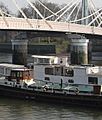Albert Bridge facts for kids
Quick facts for kids Albert Bridge |
|
|---|---|
 |
|
| Crosses | River Thames |
| Locale | Chelsea |
| Heritage status | Grade II* listed structure |
| Characteristics | |
| Design | Suspension bridge / Beam bridge hybrid design |
| Total length | 710 feet (220 m) |
| Width | 41 feet (12 m) |
| Height | 66 feet (20 m) |
| Longest span | 384 feet 9 inches (117.27 m) (before 1973), 185 feet (56 m) (after 1973) |
| Number of spans | 4 (3 before 1973) |
| Piers in water | 6 (4 before 1973) |
| Clearance below | 37 feet 9 inches (11.5 m) at lowest astronomical tide |
| History | |
| Designer | Rowland Mason Ordish, Joseph Bazalgette |
| Opened | 23 August 1873 |
| Statistics | |
| Daily traffic | 19,821 vehicles (2004) |
The Albert Bridge is a famous road bridge that crosses the River Thames in West London. It connects the areas of Chelsea on the north side of the river with Battersea on the south side.
Contents
Building the Albert Bridge
The Albert Bridge was first designed and built in 1873. It was meant to be a cable-stayed bridge, which uses strong cables to support the bridge deck. However, it turned out not to be strong enough.
Later, between 1884 and 1887, a famous engineer named Sir Joseph Bazalgette added parts of a suspension bridge design. A suspension bridge uses large cables hung between towers to hold up the roadway. More work was done in 1973 to make it even stronger. Because of all these changes, the Albert Bridge today is a mix of three different bridge styles.
A Bridge with a Story
When it first opened, the Albert Bridge was a toll bridge. This meant people had to pay a small fee to cross it. But not many people used it, so it didn't make much money.
Six years later, the bridge became public property, and people no longer had to pay to cross. The small tollbooths where people paid are still there today. They are the only old bridge tollbooths left in London!
The bridge has a fun nickname: 'The Trembling Lady'. This is because it used to shake when many people walked over it at once. There are even signs at the entrances that tell soldiers from the nearby Chelsea Barracks to "break step" when crossing. This means they should not march in rhythm, to stop the bridge from shaking too much.
Keeping the Bridge Safe
The bridge's roadway is only about 27 feet (8.2 m) wide. It also had some weak spots in its structure. This made it hard for the bridge to handle lots of modern car traffic.
Even so, the Albert Bridge has mostly stayed open to vehicles. It has only closed for short times for repairs. It is one of only two Thames road bridges in central London that have never been completely replaced.
Over time, the bridge's structure continued to get damaged. To keep it safe, strict rules were put in place about how many cars can use it. This helps to make the bridge last longer. It is now one of the quietest road bridges over the Thames in London.
In 1992, the bridge was given new wiring and painted in a very bright and unusual colour scheme. This was done so that boats on the river could see it easily, especially in bad weather. At night, the bridge lights up with 4,000 bulbs. This makes it one of the most eye-catching sights in West London.
In June 2012, the Albert Bridge was part of a special event. It was on the route of Queen Elizabeth II's Diamond Jubilee Pageant on the Thames. The Royal Barge, which carried the Queen, started its journey from a pier right next to the Albert Bridge.
Related pages
Images for kids








